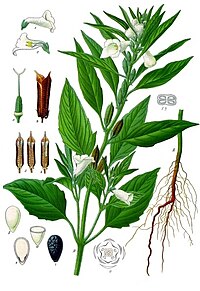
Photo from wikipedia
This study explored the potential of sesame (Sesamum indicum L.) plant residue (SPR) for bioethanol production. Three particle sizes, including 400, 850 and 1300 µm of SPR, were subjected to microbial… Click to show full abstract
This study explored the potential of sesame (Sesamum indicum L.) plant residue (SPR) for bioethanol production. Three particle sizes, including 400, 850 and 1300 µm of SPR, were subjected to microbial degradation by Phanerochaete chrysosporium followed by 1% H2SO4 pretreatments. FTIR and HPLC analyses showed that the combined pretreatment which begins with microbial followed up by acid degraded SPR in the finest particle size (400 µm) resulted in the maximum contents of reducing sugars (370.23 mg·g-1). Kinetics studies of the pretreatment process also confirmed the maximized rate of hemicellulose and lignin reduction with reducing sugars production. The logistic model had better fitness as compared to the modified Gompertz model to predict bioethanol production. SPR gave a maximum of 1.90 g·L-1 bioethanol yield after 60 h of fermentation using Saccharomyces cerevisiae. This study is the first report on bioethanol production from SPR, which proposed its suitability for sustainable energy production.
Journal Title: Bioresource technology
Year Published: 2019
Link to full text (if available)
Share on Social Media: Sign Up to like & get
recommendations!